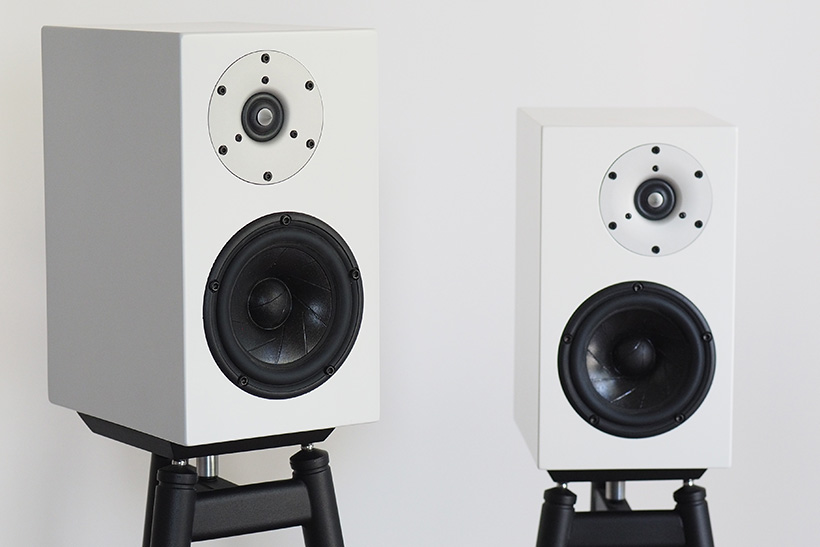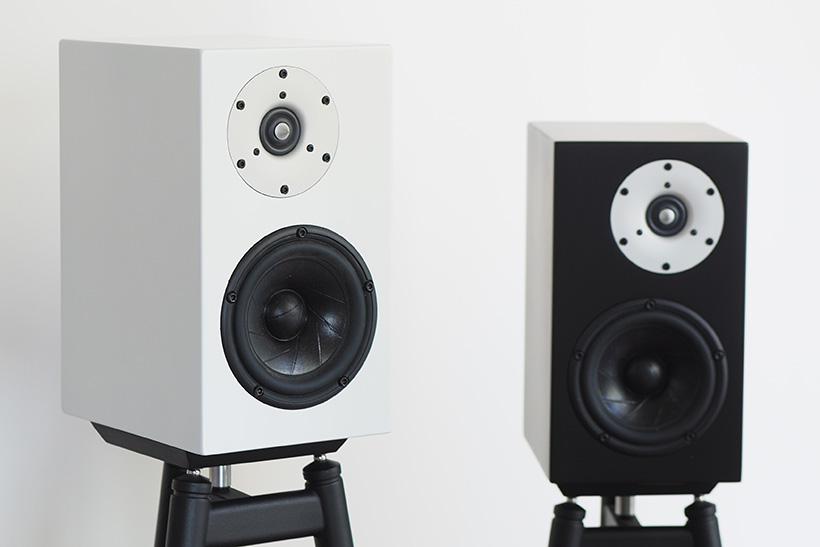Australia is not a country that’s often associated with high-end audio, I imagine that most of us would struggle to name a single manufacturer based there without the aid of a search engine. I first read of Serhan Swift a few years back when a friend paid a visit to their factory whilst on holiday in Sydney. He subsequently reviewed the Mk1 version of the Mµ2 for another publication. Serhan Swift is Brad Serhan and Morris Swift. Brad is a well-known and respected speaker designer in Australia, having started the speaker company Orpheus in the mid-eighties. His designs have been used in various professional applications including mastering suites and radio stations. Before starting up Serhan Swift he worked as a consultant, designing speakers in Australia and the US.
Morris Swift’s background was originally in the design of micro-electronics, notably those used in the medical field. As an audiophile he has been designing and building audio electronics throughout his working life, particularly active speakers with room correction DSP. The Mµ2 was the first production speaker from Serhan Swift, followed by an SE version. The Greek character ‘µ’ means micro, which describes the comparative physical form of the speaker. Here we look at the MkII version of the Mµ2, which retails at £6,499.

Design and Build
The Mµ2 MkII is a compact speaker that’s just over a foot high and weighs 17 lbs. It’s technically a bookshelf design but as placing a speaker on such a platform is unlikely to extract a performance approaching its maximum potential this is not very apt. Part of the design was carried out using Solid Steel SS-6 stands, which were supplied with the M MkIIs for this review by the UK distributor, Mian Audio. Sensitivity is quoted at 84db with a nominal impedance of 6 Ohms so this speaker needs a bit of power behind it.
The cabinets, which are a rear-ported reflex design, are made out of a four-layer sandwich of birch-ply and MDF which is asymmetrically braced to increase cabinet stiffness. Tapping the cabinet suggests that they achieved their goal, the box feels notably solid with no sign of ringing. The crossover is a high-order discrete design featuring Solen premium quality air core inductors, polypropylene capacitors and non-inductive resistors. Components are tested and matched to be as close to identical as possible for each speaker in a pair. Great care is taken over the placement of each component and isolation material from Les Davis Audio is used on certain components. To help ensure each pair of speakers are perfectly matched, cabinet damping material is weighed and placed in precisely the same place within each speaker cabinet.
The drive units are from the Scanspeak Revelator series and found in some costly designs from the likes of Wilson Audio and Sonus Faber. The mid/bass is a five-inch affair with an exceptionally long throw to help produce a bass response that belies the size of the cabinet. The tweeter is a ring radiator type that’s said to offer exceptionally wide dispersion. This claim was demonstrated by the distributor, Andy Moore, who performed the initial set-up in my listening room. He was able to move the speakers closer together to offer a more pinpoint central image without it noticeably reducing the width of the soundstage. Whilst the main driver is mounted centrally within the lower portion of the cabinet, the tweeter is offset in order to minimise baffle diffraction. According to Andy, it is crucial to set up the speakers with the tweeters on the ‘outside’ for correct imaging. The drive unit bolts are torqued to a specific value, so owners are advised not to follow the tweak of tightening them, as has been suggested by audio magazines and forums over the years. Constrained layer damping material has been custom manufactured for the Mm2 MkII by Les Davis Audio and selectively applied in the design.
At the rear of each cabinet you will find a set of single wire Cardas Rhodium cable terminals, these were chosen for quality and sonic reasons. The cabinets are painted in what the manufacturer describes as an artisan, multi-layer paint finish. My review sample was a silk white, the single alternative colour being silk black. They come with grilles which, although more sonically transparent than those of many other speakers I have had at home, were left off for critical listening.
Each pair of speakers takes three days to build, with the final tests carried out by Brad, after which both he and Morris sign each unit. Every speaker must follow a set impedance curve before it is considered finished.
Listening
To give a bit of background, I requested the review pair after being extremely impressed with what I heard at the Northwest Audio Show, held at Cranage Hall last June. I was not the only one to be impressed as the room picked up a few ‘best in show’ nominations, despite the system feeding them being relatively affordable compared to many of the other systems being used at the show. What impressed me most was the enormous soundstage which gave a great impression of depth, width and height. The presentation was lively and highly entertaining, yet smooth and precise, with a sense of punch and impact despite their small stature. The mid and treble did get a little hard when the distributor got carried away with the volume control, but they were fed with equipment that was unfamiliar and getting great sound in the hotel rooms used at shows is always a challenge.

The Mµ2 MkIIs replaced my much larger Totem Forest Signature floorstanding speakers. Whilst I was initially very impressed with the results, the sonic balance is significantly different, so I was grateful to be able to live with these speakers for some weeks before summing up my thoughts. As usual, my source was a Melco NA1/2 server streamer and S100 network switch feeding a Simaudio Moon 780D DAC via the excellent Network Acoustics ENO cable and filter, Moon 600i amp and Tellurium Q Ultrablack II cables and interconnects.
As I have learnt from experience, making assumptions can be dangerous and audio is no exception. One may assume that small speakers such as Mµ2 MkII’s will sound best with small-scale acoustic music, and they sound lovely when that is what you are in the mood to listen to. Joni Mitchell’s Blue (24/192 FLAC) sounded beguiling. It was as if the years were rolled back and she was there in my front room, with the piano very precisely to the left of the soundstage. However what surprised me was how well they played all types of music. Every track I played sounded great. Sure, the bass, although very fast, detailed, direct and tonally accurate, doesn’t have the sheer depth and slam of larger speaker designs, although it does a better job than you have any right to expect. Once I had adjusted to this, I did not give it a second thought and enjoyed everything that they played.
They are also quite surprising. Firstly, these speakers can really play metal. Slayer’s South Of Heaven (Qobuz 24/192) sounded more involving via these tiny speakers than anything else I have listened to it through over the last thirty-five or so years. The guitars screamed, the drums hit hard, and the bass stops and starts on a coin, yet the cymbals sounded sweet and precisely timed. A CD rip of Korn’s eponymous debut album had me so gripped that I played it through in its entirety without having any intention of doing so. This album was recorded in the grounds of a hillside ranch, with the band playing together during the recording sessions. The Mµ2 MkIIs made it sound thoroughly believable, the drums presented in their own acoustic space at the rear of the soundstage, the bass guitar ripping through my room with such speed and agility that it felt like my eyes were on stalks. If this makes it sound like they are overly upfront and falsely detailed, that’s not what I’m suggesting. They simply give you a detailed account of what is on the recording. I didn’t feel they were overly bright or harsh in my system.
They will tell you if the recording is somewhat coarse. The Coral’s Goodbye, from a CD rip of their self-titled first album sounded a little grainy at first, yet the speed, timing and dynamics meant I could thoroughly enjoy the music. The lead guitar was positioned well to the left of the soundstage, higher than the rest of the band; rarely have I experienced such precise height information in my room. The balance is akin to being sat in the front row of a concert, you get the impression that they present every detail of the performance, in an unforced manner. To emphasise this point, I thoroughly enjoyed the infamous early victim of the loudness wars, Californication by The Red Hot Chilli Peppers (CD rip). Whilst the limitations of the recording were there to hear if you listened for them, the timing qualities of the Mµ2 MkII meant I could enjoy a great song and superb musicianship. The resolving power and incredible speed of these speakers clearly helps to minimise distortion in the high frequencies.

I was fortunate to have seen Kae Tempest live a few months back. The track Don’t You Ever from The Line Is A Curve (24/96 FLAC) allowed the Mµ2 MkIIs to demonstrate their fine timing qualities. The bass was robotic, the vocals were delivered in their own space and sounded extremely natural. During the chorus, the punctuation of the cymbal effects was completely hypnotic, far more so than I experienced at the concert.
Dead Can Dance recorded some of their albums in an old Church in County Cavan, in the Republic of Ireland. The sense of acoustic, fabulously captured on their most celebrated album Into The Labyrinth (MoFi SACD rip) was superbly portrayed. I played it to Andy after he had set up the speakers in my room. Both the band and the album were unknown to him yet so accurate was the sense of acoustic depicted by the speakers that when I asked him what type of building he thought it had been recorded in, he immediately guessed correctly.
Conclusion
The Serhan Swift Mµ2 MkIIs offer something decisively different to other speakers at their price point. Never before have I experienced such speed and natural definition without the fatigue that often accompanies such a level of detail. They present a large, precise soundstage that appears accurate in all three dimensions. The speakers they replaced in my room have considerably deeper bass but lack the speed and punch offered here. Those with bigger rooms may choose to add a sub, but such a device would need to be up to the task of matching the Mµ2 MkII’s speed if it is not to be left behind. The speakers are exceptionally built and well-finished, albeit compared to models from Sonus Faber and Focals, the design could be described as ‘functional’. The Mµ2 MkIIs are designed for making music, and when fed by a high-quality system, they deliver that in spades.


